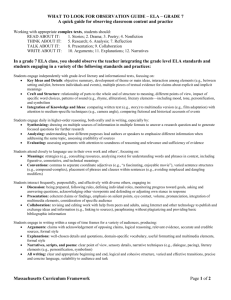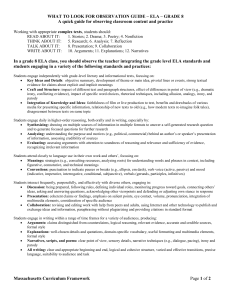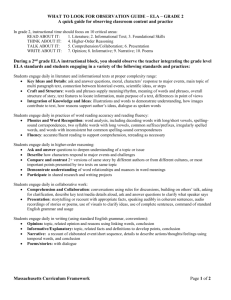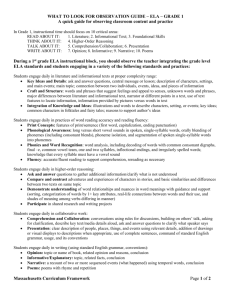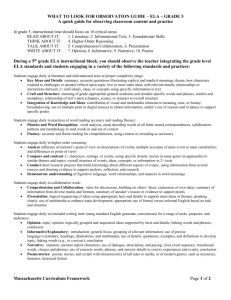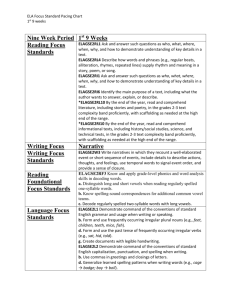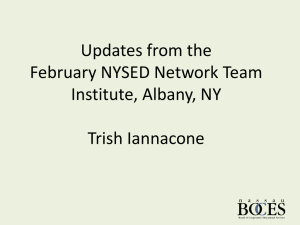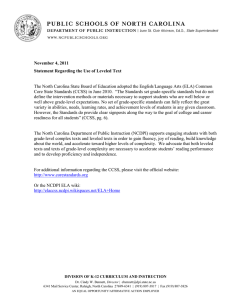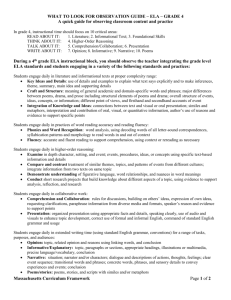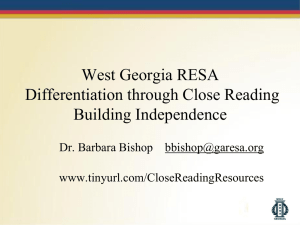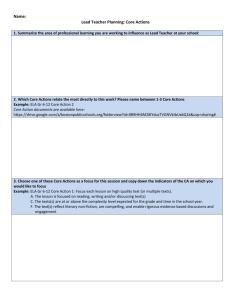What To Look For ELA Grade 6
advertisement
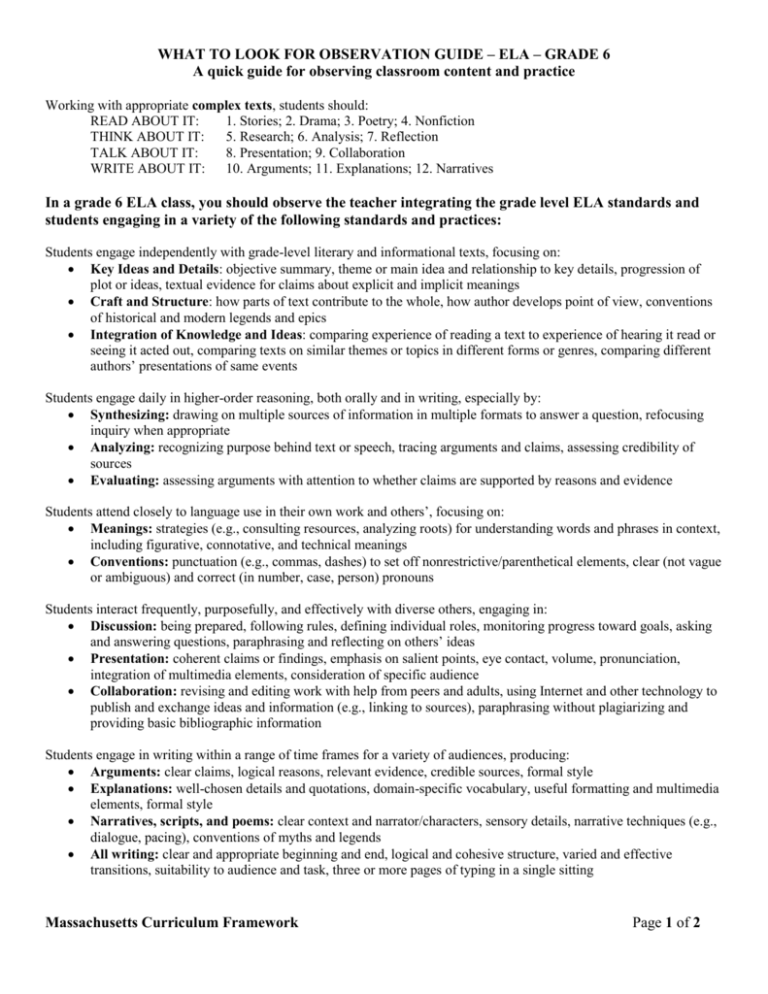
WHAT TO LOOK FOR OBSERVATION GUIDE – ELA – GRADE 6 A quick guide for observing classroom content and practice Working with appropriate complex texts, students should: READ ABOUT IT: 1. Stories; 2. Drama; 3. Poetry; 4. Nonfiction THINK ABOUT IT: 5. Research; 6. Analysis; 7. Reflection TALK ABOUT IT: 8. Presentation; 9. Collaboration WRITE ABOUT IT: 10. Arguments; 11. Explanations; 12. Narratives In a grade 6 ELA class, you should observe the teacher integrating the grade level ELA standards and students engaging in a variety of the following standards and practices: Students engage independently with grade-level literary and informational texts, focusing on: Key Ideas and Details: objective summary, theme or main idea and relationship to key details, progression of plot or ideas, textual evidence for claims about explicit and implicit meanings Craft and Structure: how parts of text contribute to the whole, how author develops point of view, conventions of historical and modern legends and epics Integration of Knowledge and Ideas: comparing experience of reading a text to experience of hearing it read or seeing it acted out, comparing texts on similar themes or topics in different forms or genres, comparing different authors’ presentations of same events Students engage daily in higher-order reasoning, both orally and in writing, especially by: Synthesizing: drawing on multiple sources of information in multiple formats to answer a question, refocusing inquiry when appropriate Analyzing: recognizing purpose behind text or speech, tracing arguments and claims, assessing credibility of sources Evaluating: assessing arguments with attention to whether claims are supported by reasons and evidence Students attend closely to language use in their own work and others’, focusing on: Meanings: strategies (e.g., consulting resources, analyzing roots) for understanding words and phrases in context, including figurative, connotative, and technical meanings Conventions: punctuation (e.g., commas, dashes) to set off nonrestrictive/parenthetical elements, clear (not vague or ambiguous) and correct (in number, case, person) pronouns Students interact frequently, purposefully, and effectively with diverse others, engaging in: Discussion: being prepared, following rules, defining individual roles, monitoring progress toward goals, asking and answering questions, paraphrasing and reflecting on others’ ideas Presentation: coherent claims or findings, emphasis on salient points, eye contact, volume, pronunciation, integration of multimedia elements, consideration of specific audience Collaboration: revising and editing work with help from peers and adults, using Internet and other technology to publish and exchange ideas and information (e.g., linking to sources), paraphrasing without plagiarizing and providing basic bibliographic information Students engage in writing within a range of time frames for a variety of audiences, producing: Arguments: clear claims, logical reasons, relevant evidence, credible sources, formal style Explanations: well-chosen details and quotations, domain-specific vocabulary, useful formatting and multimedia elements, formal style Narratives, scripts, and poems: clear context and narrator/characters, sensory details, narrative techniques (e.g., dialogue, pacing), conventions of myths and legends All writing: clear and appropriate beginning and end, logical and cohesive structure, varied and effective transitions, suitability to audience and task, three or more pages of typing in a single sitting Massachusetts Curriculum Framework Page 1 of 2 WHAT TO LOOK FOR OBSERVATION GUIDE – ELA – GRADE 6 ELA What to Look For Guide The practices below, which fall under Standards I and II of the MA Model Teacher Rubric, should be evident in planning and instruction. Any particular lesson will demonstrate some of the practices, not all. For each lesson, artifacts or observables might include: lesson plan, tasks and assessments, teacher instruction, student discussion and behavior, or student work. Student Practices Teacher Practices Curriculum, Planning, and Assessment Curriculum, Planning, and Assessment Appear consistently engaged and motivated to learn. Participate in constructive conversations with teacher about how to improve their performance. Teaching All Students Challenge themselves, take academic risks, and ask for support when appropriate. Demonstrate respect for and affirm their own and others’ differences related to background, identity, language, strengths, and challenges. Engages students in tasks that relate to grade-level standards for reading, writing, speaking, listening, and/or language. Communicates objectives clearly and provides timely, descriptive feedback to students on their progress and performance. Communicates and supports language objectives for English language learners in a clear, explicit way. Requires that students use higher-order thinking skills in interactions with text, teacher, and one another. Structures lesson well, effectively managing pacing, sequence, activities, materials, resources, technologies, and grouping. Teaching All Students Effectively models ways in which students can access challenging texts through the use of specific strategies. Communicates clear, consistent, and high expectations for student work, using rubrics, exemplar texts, and guided practice as appropriate. Provides scaffolding and accommodations (graphic organizers, pre-taught vocabulary, reading partners, etc.) for English learners, students with disabilities, and other students who need help accessing the curriculum. Provides opportunities for students to read, write, speak, and listen in diverse groups. NOTES: See the full set of Standards and Indicators in ESE’s Model Teacher Rubric (http://www.doe.mass.edu/edeval/model/PartIII_AppxC.pdf). Massachusetts Curriculum Framework Page 2 of 2
